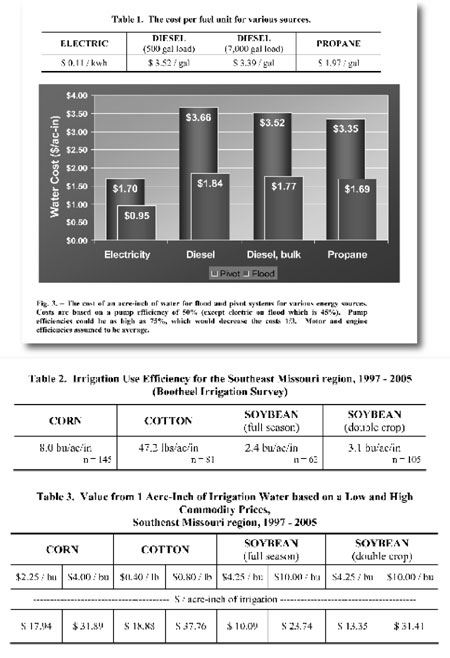Energy Prices Are Topsy-Turvy But Irrigation Still Pays The Bills
PORTAGEVILLE, MO.
Increased energy costs
ratchet up farming costs in
many ways: diesel to run
our equipment is higher and
cost is added to fertilizers,
drying, and hauling prices.
However, for the irrigator the
highest fuel bill on his farm is
probably the one for running
those irrigation pumps.
Also, energy costs are frustratingly fickle making
it hard to strategize. Three weeks ago I wrote
an article saying not to choose propane power
units, and instead use diesel if electricity wasn’t
an option. Since then diesel prices have risen
70 cents a gallon, now making propane more
economical then diesel. With higher fuel costs
and volatile prices the first reaction may be to
cut irrigation off. However, doing so would be
like throwing the baby out with the water. Irrigation
is still paying for itself.
One excellent way to examine the bang we are
getting for our irrigation buck is to look at the irrigation
use efficiency (IUE). IUE is the amount
of supplemental yield we get from irrigation divided
by the inches of irrigation water applied.
For example, assume a farmer made 180 bu/ac
inside his pivot, 115 bu/ac in the dry pivot corners,
and had applied 10 inches of irrigation
water. IUE would be (180 bu/ac – 115 bu/ac) /
10 in = 6.5 bu/ac per inch.
IUE is a good analysis tool since it isolates the
investment cost of pumping along with its derived
yield benefit. The cost of pumping an
acre-inch of water depends on (a) fuel source
and (b) method of irrigation. Electricity still remains
the cheapest energy source. The most
recent survey (Mar 12, 2008) of fuel costs in
Southeast Missouri (SEMO) is seen in Table 1.
The cost of water for pivots will be higher then
the cost for flood irrigation due to the added
pressure requirements. Although individual situations
vary, the average cost for an acre-inch
of water for pivot and flood based on the above
fuel costs is seen in Figure 1. Costs range from
a low of $0.95 per ac-in for electricity on flood to
a high of $3.66 for diesel (500 gallon bulk) with
pivots.

The important question now is whether the
added yield we make from each acre-inch offsets
the costs in Figure 1. Data from the annual
Bootheel Irrigation Surveys (BIS) seems to indicate
that it does. First, Table 2 shows IUE data
from these surveys.
Table 3 shows the gross returns stemming
from an acre-inch of irrigation water. Using a
low commodity price (the left hand side on each
commodity column) we see that gross returns
for the four crops range from a low of $10.09 (for
full-season soybeans) to $18.88 (for cotton).
Using the high commodity price, more typical of
current prices, the range is $23.74 (for full-season
soybeans) to $37.76 (for cotton). Clearly,
even when using low commodity prices, all
crops showed profit, even with the most expensive
irrigation water, the pivot on diesel.
Actually, the expected gross returns per acreinch
of irrigation could actually be higher then
shown in Table 3, especially for soybeans. This
is because the dataset used to estimate IUE
goes back to 1997 when irrigated soybean yields
were not like they are today.
Although the above argues for applying irrigation,
almost every year in SEMO there will be
certainly irrigated fields that make no more, or
even less, yield then the dryland portions of that
field. Even the best irrigators find that this occasionally
happens to them. Using BIS data
since 1997 we see that number of instances
when dryland yields were as great or greater
then irrigated yields was 4.0 percent for doublecrop
soybeans, 5.6 percent for corn, 8.2 percent
for full-season soybeans, and 9.3 percent for
cotton. However, even when factoring in these
off years, and even with the current high energy
costs, irrigation remains profitable. Averaging
the commodity values in Table 3 (the higher
ones is used since it is closer to today’s prices)
and using $3.66/acre-inch, which represents
the highest possible water cost, we see that the
returns on pumping costs are about 700 percent.
Δ
Dr. Joe Henggeler is Irrigation Specialist with
the University of Missouri Delta Center at
Portageville.